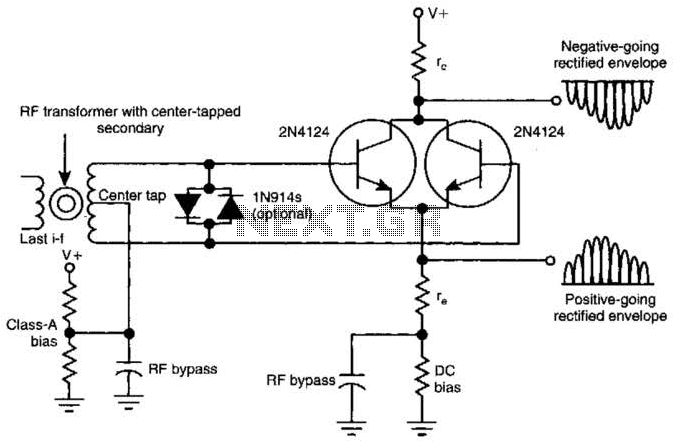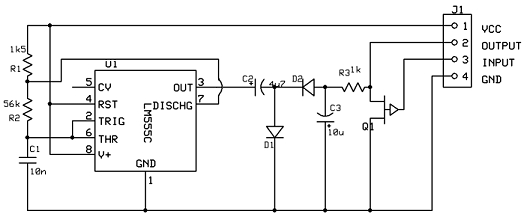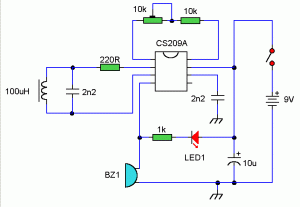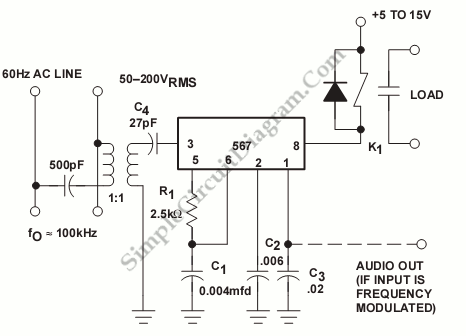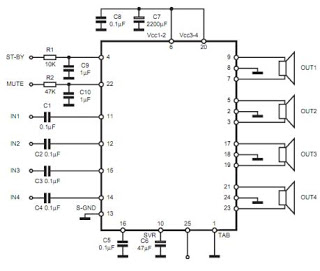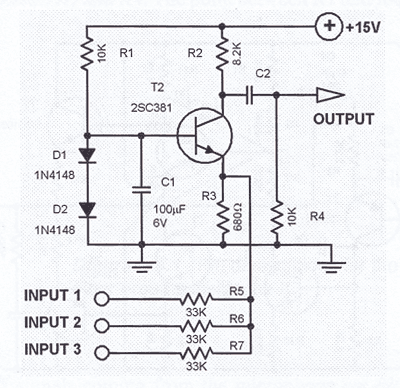
Anti-theft car audio system circuit diagram
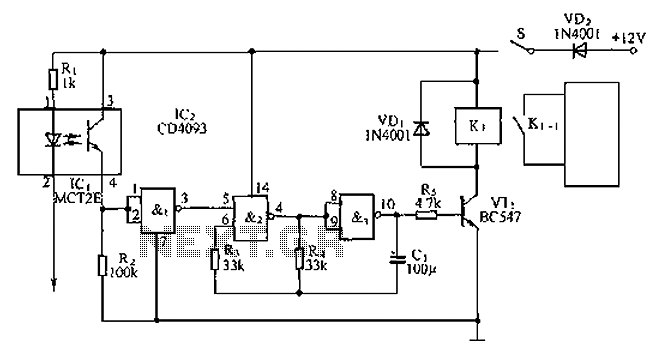
An anti-theft car audio system circuit is depicted, powered by a 12V DC supply from the car battery. Upon closing switch S1, the light-emitting diode in optocoupler IC1 activates, causing the phototransistor to conduct. This results in a high-level output from IC1 to the NAND gate, which then outputs a low signal. The low signal increases the input to NAND gate 2, which is part of a low-frequency oscillator circuit comprising NAND gates 2 and 3, placing the entire system in a standby alert state. If an intruder cuts the audio cable, the optocoupler's internal light-emitting diode is deactivated, leading to a low output from IC1. Consequently, NAND gate 1 outputs a high signal, which triggers the low-frequency oscillator formed by NAND gates 2 and 3 to generate an oscillation signal. This signal controls transistor VT1, activating relay K1. When relay K1's normally open contact K1-1 closes, it triggers a beeper alarm, emitting a loud sound to draw attention.
The anti-theft car audio system circuit is designed to provide an effective security measure for vehicles by monitoring the integrity of the audio system wiring. The circuit operates on a 12V DC power supply sourced directly from the vehicle's battery, ensuring reliable operation.
The circuit's operation begins with the closure of switch S1, which activates the optocoupler IC1. The internal light-emitting diode within the optocoupler illuminates, causing the phototransistor to conduct. This conduction results in a high output signal from IC1, which is fed into the first NAND gate. The output of this gate turns low, effectively signaling the second NAND gate, which is part of a low-frequency oscillator configuration involving NAND gates 2 and 3. While in this state, the circuit remains vigilant, ready to respond to any unauthorized tampering.
In the event that an intruder attempts to disable the audio system by cutting the audio cable, the interruption in the circuit causes the internal light-emitting diode of the optocoupler to cease operation. As a result, the output from IC1 drops to low, which in turn causes the first NAND gate to output a high signal. This change activates the low-frequency oscillator formed by NAND gates 2 and 3, producing an oscillation signal.
The oscillation signal is utilized to control transistor VT1, which acts as a switch for relay K1. When the relay is energized, its normally open contact K1-1 closes, completing a circuit that activates a beeper alarm. The alarm emits a loud sound, effectively alerting nearby individuals to the potential theft and deterring the intruder.
This circuit not only provides a straightforward method for monitoring the audio system but also incorporates essential components such as optocouplers and NAND gates to ensure reliable operation and quick response to unauthorized access. The design emphasizes simplicity and effectiveness, making it an ideal solution for enhancing vehicle security.Anti-theft car audio system circuit is shown, which is taken from the car battery 12V DC power supply. When after closing the switch S1. Optocoupler IC1 light emitting diode is lit, the internal light due phototransistor conduction, IC1 outputs a high level input to the NAND gate, the NAND gate 1 output low. The low increase in NAND gate 2 input feet, is controlled by a NAND gate 2, 3 consisting of NAND gate low frequency oscillator to stop, so that the entire circuit is in waiting alert state.
When the thieves cut the audio cable, since the optocoupler to the negative electrode inside the light-emitting diodes have been cut off at this time, so that IC1s feet vacant, internal light emitting diode immediately stop working, IC1 pin output low, NAND gate 1 output high, the NAND gate 2,3 consisting of a low frequency oscillator starts oscillation signal output control VT1 and intermittent relay K1: K1 normally open contact K1-1 also closed when closing time control a beeper alarm will sound a loud alarm will attract attention.
The anti-theft car audio system circuit is designed to provide an effective security measure for vehicles by monitoring the integrity of the audio system wiring. The circuit operates on a 12V DC power supply sourced directly from the vehicle's battery, ensuring reliable operation.
The circuit's operation begins with the closure of switch S1, which activates the optocoupler IC1. The internal light-emitting diode within the optocoupler illuminates, causing the phototransistor to conduct. This conduction results in a high output signal from IC1, which is fed into the first NAND gate. The output of this gate turns low, effectively signaling the second NAND gate, which is part of a low-frequency oscillator configuration involving NAND gates 2 and 3. While in this state, the circuit remains vigilant, ready to respond to any unauthorized tampering.
In the event that an intruder attempts to disable the audio system by cutting the audio cable, the interruption in the circuit causes the internal light-emitting diode of the optocoupler to cease operation. As a result, the output from IC1 drops to low, which in turn causes the first NAND gate to output a high signal. This change activates the low-frequency oscillator formed by NAND gates 2 and 3, producing an oscillation signal.
The oscillation signal is utilized to control transistor VT1, which acts as a switch for relay K1. When the relay is energized, its normally open contact K1-1 closes, completing a circuit that activates a beeper alarm. The alarm emits a loud sound, effectively alerting nearby individuals to the potential theft and deterring the intruder.
This circuit not only provides a straightforward method for monitoring the audio system but also incorporates essential components such as optocouplers and NAND gates to ensure reliable operation and quick response to unauthorized access. The design emphasizes simplicity and effectiveness, making it an ideal solution for enhancing vehicle security.Anti-theft car audio system circuit is shown, which is taken from the car battery 12V DC power supply. When after closing the switch S1. Optocoupler IC1 light emitting diode is lit, the internal light due phototransistor conduction, IC1 outputs a high level input to the NAND gate, the NAND gate 1 output low. The low increase in NAND gate 2 input feet, is controlled by a NAND gate 2, 3 consisting of NAND gate low frequency oscillator to stop, so that the entire circuit is in waiting alert state.
When the thieves cut the audio cable, since the optocoupler to the negative electrode inside the light-emitting diodes have been cut off at this time, so that IC1s feet vacant, internal light emitting diode immediately stop working, IC1 pin output low, NAND gate 1 output high, the NAND gate 2,3 consisting of a low frequency oscillator starts oscillation signal output control VT1 and intermittent relay K1: K1 normally open contact K1-1 also closed when closing time control a beeper alarm will sound a loud alarm will attract attention.
Warning: include(partials/cookie-banner.php): Failed to open stream: Permission denied in /var/www/html/nextgr/view-circuit.php on line 713
Warning: include(): Failed opening 'partials/cookie-banner.php' for inclusion (include_path='.:/usr/share/php') in /var/www/html/nextgr/view-circuit.php on line 713
